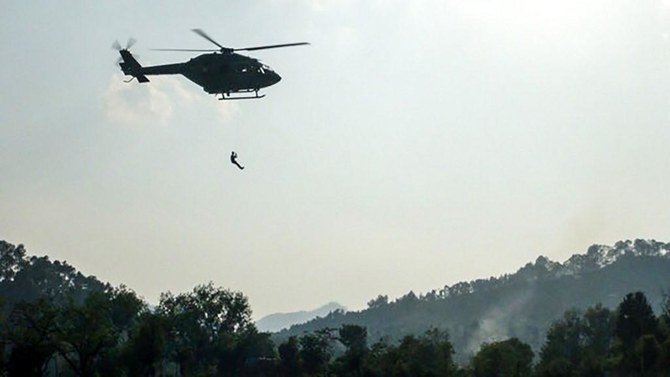India begins ‘high-risk’ retrieval of dead Himalayan climbers

An Indian helicopter carrying elite paramilitary mountaineers took off Wednesday for a “very high-risk” operation to retrieve five dead climbers and three others believed killed scaling a treacherous Himalayan peak.
Air Force choppers spotted five bodies Monday on the slopes of Nanda Devi in India’s high north while looking for the four Britons, two Americans, one Indian and one Australian believed killed by an avalanche last week.
The remains of the three others, all part of originally a 12-member team led by highly experienced British climber Martin Moran, were believed to be nearby. Four other Britons split from the bigger group and were rescued on the weekend.
Wednesday’s operation began at 5:00 am (2330 GMT) when a military helicopter with four Indo-Tibetan Border Police (ITBP) mountaineers and five Air Force personnel left the nearby hill town of Munsyari.
The ITBP climbers were to be dropped by the helicopter 18,000-20,000 feet (5,500-6,100 meters) up India’s second-highest mountain, police spokesman Vivek Kumar Pandey told AFP.
Pandey on Tuesday described the mission as “a very high-risk and high-altitude operation” in a zone where avalanches are frequent.
“In recent times such a high-altitude retrieval has not been carried out in Indian mountains,” he added.
The team led by Moran had permission to climb the eastern peak of Nanda Devi but a Facebook post by Moran’s mountaineering firm on May 22 said that they planned to attempt “an unclimbed peak” around 6,500 meters high.
“This mountain range is more difficult to scale than Mount Everest. They knowingly risked their lives after changing their plans without informing the authorities,” an official involved in the operation told AFP on condition of anonymity on Tuesday.
“The permission was granted for Nanda Devi east, and any diversion is illegal. We were completely unaware of their changed plan and that turned fatal,” he said.
Officials said the 12 climbers had set out from Munsyari but separated into two groups a week later.
The groups communicated last on May 26, a day before heavy snow fell and massive avalanches hit the heights.
When the eight climbers failed to report back to the base camp, the other four launched their own search before alerting Indian authorities who started a major search operation.
A military source said the climbers may have fallen from an ice ridge or an overhanging mass of snow during the avalanches.
“There must have been some error of judgment and they must have fallen from a great height along with the entire snow cornice. It must have been like falling from a 10-story building,” the source told AFP.
“They took a different route for which they didn’t have permission. It is their adventurism which cost them their lives,” the source said.
Hundreds of climbers from across the world visit India to scale mountains across the Himalayan chain, and the peaks in Nanda Devi sanctuary are considered among the toughest.
The other climbers have been named as John McLaren, Rupert Whewell and University of York lecturer Richard Payne from Britain, US nationals Anthony Sudekum and Ronald Beimel, Australian Ruth McCance and Indian guide Chetan Pandey.
McCance’s husband Trent Goldsack told Australian media that her last communication to him had been a text message saying: “OK at base camp.”
